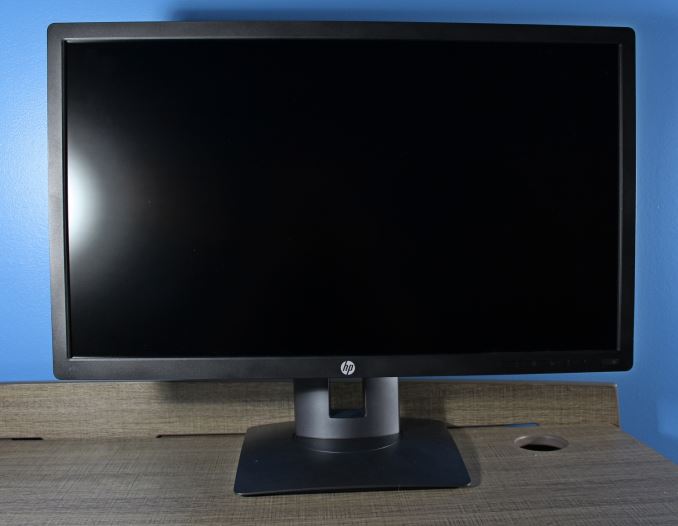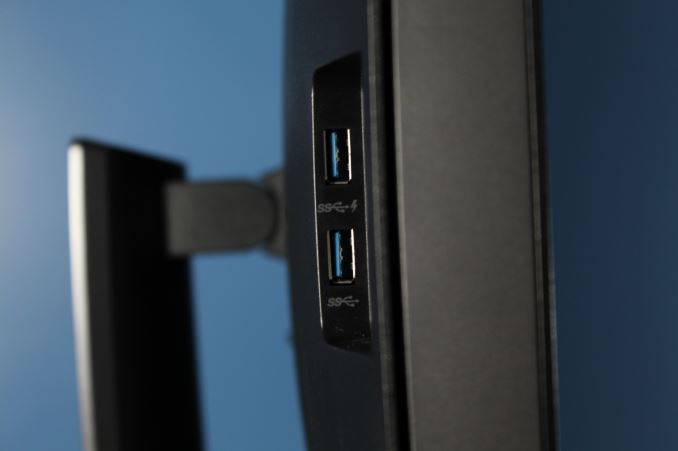HP Z27q Monitor Review: Aiming For More Pixels
by Brett Howse on December 22, 2015 8:00 AM ESTFinal Words
When HP entered the 5K market with the Z27q, the only real competition was the 27-inch Dell 5K display, but it cost close to $2000. HP came into the market with the same display dimensions and resolution, but undercut Dell by almost $800. $1200 for a display is still a lot of money, but if you are someone that needs high resolution, the HP Z27q needs to be considered.
The overall accuracy of the display is great, especially in the AdobeRGB color mode. sRGB does need some calibration of the grayscale and white point to make it practically perfect, but the calibration of the LUT at the factory by HP is quite good resulting in a decent out of the box experience. The one real issue with this display is that the backlight is uneven, dropping as high as 20% from the center when measured at the top left corner. This is pretty much the same issue that we found with the Z27x, and it would not be surprising to find that both monitors are designed similarly. It is the one blemish on an otherwise great performing display.
People looking at 5K displays have to factor in that it takes a lot of GPU power to drive these. You can’t even drive the display with a single cable; instead you have to use two DisplayPort 1.2 ports and cables to achieve the 5120x2880 resolution. This means that the display leverages MST, and while I’ve heard of people having issues with this, I did not have any issues with MST driving this display with an AMD FirePro card in Windows 10. It will still be a while before we have the DisplayPort 1.3 capabilities to drive this with just a single cable.
The construction of the HP Z27q is not going to win any style awards, but it is functional and for most people, a black monitor is all that is needed. The stand is very easy to use though, with lots of options to tilt -5° to +22°, and the swivel is plus or minus 45°.
Due to the nature of the display, input lag was not able to be tested, since the tester used is HDMI and 1080p. In my time with it, there was no noticable lag at the native resolution.
There are not too many people that need almost 15 million pixels, but there are certainly use cases for a display like this. Editing 4K video is an obvious use case, since you can have the entire 4K video in a pixel perfect window, with enough room for toolbars as well. The gamut is a long way from the Z27x offering from HP, but that is only a 2560x1440 panel. Just like the Z27x the one glaring issue is the uniformity. If HP can get on top of this, they will likely have the display to beat, especially at this price.













92 Comments
View All Comments
theduckofdeath - Wednesday, December 23, 2015 - link
Yes and no. It's very much about paying extra to be an early adopter. In many cases small scale means higher price because it requires a lot more manufacturing accuracy.Prices of these 4 and 5 k displays will plummet in a couple of years. Though, to be fair, it's no rush as GPU's really aren't able to display much else than static images, text and video on this resolution today.
CaedenV - Tuesday, December 22, 2015 - link
less material used, plus higher output capability, plus a more reliable process. It all adds up to far less cost, and far FAR less waste, so the product costs much less.Think of it this way... a 6" 16:9 display has 15.37 square inches of material. A 27" display with the same aspect ratio has an area of 311.53 square inches.
Lets say that the phone display costs ~$50 (just for the sake of nice round numbers... I have no idea what a high end cell phone display costs). That would break down to $3.25 per square inch... extrapolating that to the larger display it would scale up to $1,012.50.
But there is a difference between a cell phone display and a computer monitor. A cell display is merely the display, and the backlight with minimal controllers and other electronics, and no housing... the monitor has a USB3 hub ($), a stand ($$), a housing ($), a controller supporting multiple inputs, resolutions, frequencies, and scaling ($$$), a power supply ($), higher shipping costs per unit ($), higher storage costs per unit ($) etc.
Plus, lets not forget about issues of manufacturing. Lets say that for every 1000sq" there is a defect that makes a device unusable. That means that for every ~67 cell phone displays, there is one bad apple, so the average cost of each display rises ~1/67th, or 75 cents per unit.
But if that same kind of manufacturing ratio is applied to the larger screen, then that means that one out of every 4 displays is going to be bad, which means a 25% increase in screen price (+$253 per unit! way more than 75 cents!).
TL;DR... smaller things are going to cost less.
Frenetic Pony - Tuesday, December 22, 2015 - link
Size of the display matters more than PPI of the display in terms of cost.DominionSeraph - Tuesday, December 22, 2015 - link
Could you possibly have taken worse photos? Bland, poorly lighted in intensity and color, and at really unflattering angles.The first pic looks crooked because of the angled countertop back. The second IS crooked.
This doesn't look like a professional review of a $1000 monitor, it looks like a Craigslist ad for a $15 one.
ImSpartacus - Tuesday, December 22, 2015 - link
Whew, being a little toasty, eh?It's clear that the photography is subpar, but it might be helpful to provide some explanations to fix the noted issues.
Anandtech is all about learning stuff that you didn't previously know, so I'm sure the reviewer would appreciate some learning in the "opposite" direction under these circumstances.
K_Space - Tuesday, December 22, 2015 - link
Agreed! Helpful feedback goes a long way:1) intense flash photography tends to create harsh shadow and poor exposure of the background. Use a DIY or cheap soft box (or point flash toward a WHITE ceiling). You can manually reduce flash power or simply stand back more.
2) Use a virtual grid in the optical view finder. By default intensely geometrical shapes like the first picture will likely bring out all the faults in the lens designs (definite barrel distortion in the first picture). Simple correction in LR. Lots of freebie tools do a similar job if you are not Adobe inclined.
3) Use a white background; this will also help create a reference point for white balance.
fanofanand - Tuesday, December 22, 2015 - link
In the last year I see comments regarding the photography in nearly every article, to the point where someone pointed out Josh's lack of arm hair (weird thing to notice). I don't expect a technical journalist to also be a professional photographer. It's the review that's important, not the photos....K_Space - Tuesday, December 22, 2015 - link
Except there is nothing professional about the tips above (mind you the OP was a bit harsh). It's at best a bit of tidying up. Good presentation never hurt's anyone. Certainly the review is important and in Brett's defence these pix are still better than some of the shots you get in TFT central and I wouldn't fault their reviews either.RT81 - Tuesday, December 22, 2015 - link
I'd almost prefer they'd err on the side of having photos like this rather than the alternative. Sometimes reviewers go overboard with the slickness of the photos to where I wonder if they'd be better off just working for the marketing department of the manufacturer. I find it nice to see frank, no-nonsense, non-shopped photos of hardware in-situ. That monitor sure as hell isn't going to look nice and new after a month or two sitting on MY desk.damianrobertjones - Tuesday, December 22, 2015 - link
Totally agree. Someone there MUST be able to use a camera. It is a tech site after all.